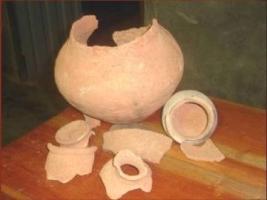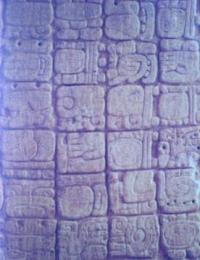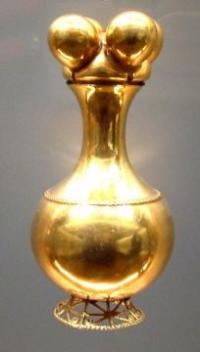Copy Link
Add to Bookmark
Report
HOMEBREW Digest #0508

This file received at Mthvax.CS.Miami.EDU 90/10/02 03:19:18
HOMEBREW Digest #508 Tue 02 October 1990
FORUM ON BEER, HOMEBREWING, AND RELATED ISSUES
Rob Gardner, Digest Coordinator
Contents:
dark beer (Richard J Lavin)
yeastie beasties (Heidi Schlitt)
Hard Cider recipie (jwhite)
Brewing Talk @ Xerox PARC (dw)
Re: Priming (Algis R Korzonas +1 708 979 8583)
Re: Slugs and Beer (Nick Dais)
Maltose (John S. Watson - FSC)
Sweetness & Temperature, etc.. (Jay Hersh)
Chimay recipe. ("SIXTO A. GONZALEZ")
Pyment; brewpubs; trub ("FEINSTEIN")
Germany - Part 4 (Norm Hardy)
kegging vs bottling (Bill Crick)
Send submissions to homebrew%hpfcmr@hplabs.hp.com
Send requests to homebrew-request%hpfcmr@hplabs.hp.com
[Please do not send me requests for back issues]
Archives are available from netlib@mthvax.cs.miami.edu
----------------------------------------------------------------------
Date: Fri, 28 Sep 90 23:25:44 EDT
From: mvrjl1@mvgpn.att.com (Richard J Lavin)
Subject: dark beer
This is my first post I would like to know
[A[P[P[P[P[P[P[P[P[P[P[P[P[P[P[P[P[P[P[P[P[P[P[P[P[P[P[P[P[P[P[P[P[P[P[P[P[P[P[P[P[P[P[P Hi homebrewers
This is my first post I like dark beer can anyone tell me
l[Alllllllj[D[D[D[D[D[D[D[DThis is[P my first post I realy like dark beer. Can anyone
tell me whats the difference in brewing dark and regular beer?
I bought a 6pack of samual adams octoberfest beer this week.
I realy enjoyed it the first time I bought sam a. I thought
it had a bad after taste. After reading this group I tried it
again. The first rack must have spoiled. Because the second
one was great!!
------------------------------
Date: Mon, 1 Oct 1990 8:13:07 MDT
From: SQUID@zen.radiology.arizona.edu (Heidi Schlitt)
Subject: yeastie beasties
Just started my first attempt at culturing Sierra Nevada pale ale yeast. I
decanted three bottles and pitched the yeast into 2 cups of starter. The
starter was 1/4 cup dry malt extract into 2 cups water, boiled and cooled to
room temperature (75F). Fermentation began after about 36 hours and seems to be
normal except... there is a layer of what appears to be yeast clinging to the
sides of the jar at the top of the liquid along with the foam. I have never had
a starter do this before (I've only done starters about 10 times before and the
yeast has always fallen to the bottom of the jar). The ale was about 6 weeks
old according to the date code (many thanks to Pete Soper for the decoder).
There are no off smells or other signs of infection. Where should I pitch the
starter? Into my wort or out of the window? Thanks in advance for your advice.
Not worrying, but wish I had a homebrew.
squid@zen.radiology.arizona.edu
------------------------------
Date: Mon, 1 Oct 90 09:17:30 PDT
From: jwhite@anovax.enet.dec.com
Subject: Hard Cider recipie
For this recipie to turn out well DO NOT use the pasturized
apple juice you find all year round in the stores. My batch last year
took about 3 weeks before it was totally done fermenting. You will
notice an unpleasent smell during this time, but you can ignore it.
Boy, does this turn out great!!!
CAUTION PLEASE DRINK THIS STUFF WITH ANOTHER MEANS OF GETTING HOME.
ingredients
5 gallons sweet cider
3 lbs brown sugar
3 lbs honey
2 pkg champagne yeast
directions.
Using 5 gallon glass carbuoy strain 3 gallons of cider into carbuoy,
the finer the mesh the better, pulp will make the concoction smell
rank. Strain approx .5 gallon in pot on stove and heat enough
to allow the sugar and honey to be disolved thoroughly. Pour mixture
in carbuoy and finish filling the carbuoy to just bellow the neck.
You will have some cider left over so don't waste it, drink it.
Pitch the yeast and stopper the carbuoy with an airlock. Watch it
go, and when fermentation stops, bottle cider in what ever size jugs
you want. Be sure the fermentation process has stopped before
bottling. In 12 oz bottles add .25 tsp sugar, for quarts add .50
tsp and for gallons add 1 tsp. this will add a little carbonation
and prevent spoillage (vinegar)
have fun
------------------------------
Date: 28 Sep 90 12:49:49 EDT (Friday)
From: dw <wegeng@arisia.xerox.com>
Subject: Brewing Talk @ Xerox PARC
Readers in the SF Bay area may be interested in the following:
Date: Thursday, Ocober 4, 1990
Time: 4:00 - 5:00
Place: Xerox PARC Auditorium
Speaker: David W. Nehrkorn, Lockheed Corporation
Title: "Zymurgy n. Technological chemistry that deals with fermentation
processes in brewing"
The making of beer is an ancient art. It has only been within the past 100
years that we have made an effort to understand the chemistry behind it --
and we have only scratched the surface. This presentation will be in two
parts, a poster session and a lecture. The poster session will graphically
describe the various steps involved in the production of beer. In
addition, several varieties of hops and malted barley (roasted and
unroasted) will be on display. Everyone is encouraged to pinch the hops
and smell the pungent hop resins and essential oils. Chew some barley (it
tastes much like cereal) -- don't be bashful! This will be a self-paced
tour.
The lecture will be more traditional. The chemistry of the four basic beer
ingredients: barley, hops, yeast and water will be discussed. Emphasis
will be placed on the composition of each and how the brewer can manipulate
this composition to achieve the desired flavor for his beer while reducing
the risk of contamination and the productuin of "off-flavors". Finally,
the synergistic relationship of all of the ingredients will be discussed.
This Forum is OPEN. All are invited, but seating is limited and doors
will be closed when available seats are taken. Refreshments will be
served at 3:45 pm.
Hosted by Sally Peters and Giuliana Lavendel (PARC Information Center,
415-494-4994 or 494-4040)
The PARC Auditorium is located at 3333 Coyote Hill Rd. in Palo Alto. We
are between Page Mill Road (west of Foothill Expressway) and Hillview
Avenue, in the Stanford Research Park. From Page Mill Road, turn onto
Coyote Hill Road. Drive up Coyote Hill past the horse pastures; PARC is
the only building on the left, just past the crest of the hill. Park in
the large parking lot, and enter the auditorium at the upper level of the
building. The auditorium entrance is located down the stairs and to the
left of the main doors from the outside of the building.
[Too bad I'm located in NY, for it sounds like an interesting talk
(especially for novice brewers).]
/Don
------------------------------
Date: Mon, 1 Oct 90 12:11:10 mdt
From: hplabs!hp-lsd.cos.hp.com!ihlpl!korz (Algis R Korzonas +1 708 979 8583)
Subject: Re: Priming
Steve writes:
>I assume that you keggers out there don't prime, so
>you can skip this.
Not true. Although you can artificially carbonate when you keg, I prefer
natural carbonation and thus prime even when I keg.
> What works best - malt or corn sugar, and how much. Is there any
>difference in sediments, carbonation or head ? I'm about to bottle my fourth
>batch and would appreciate any advice that I could get.
I had not quite gotten the bugs out of priming with malt when I switched over
to kegging so I don't have much data here, however, the main thing to
remember when priming with malt is that corn sugar is 100% fermentable
sugar and malt extract is not. I've been told that the conversion ratio
is 20% more dry malt extract by weight should be used, but as I have
already said, I don't have much data on how well this works.
> Also - what the hell is this Wyeast (?) and why would it be better
>than the EDME dry yeast that I'm using. I guess I don't understand the
>concept of the packet that swells and the steps that you go through before
>you pitch the yeast. Is this Wyeast liquid yeast (?).
Yes, Wyeast is liquid yeast. It is also known as Brewer's Choice.
The main advantage with liquid yeast is that it is much less likely
to contain wild yeasts and bacteria than dry. I've read that switching to
liquid yeast is the biggest improvement you can make in terms of
improving your beer flavor, but since I've only recently changed to
liquid yeast (and my beer is still conditioning) I cannot give you
a first-hand account. I suggest you give Wyeast a try and see if you
like it. Regarding the steps you go through, you simply bash the heel of
your palm against the package and wait for the package to swell. Then
you can either pour the yeast into a starter, or right into the carboy.
Notice that the temperature and the age of the yeast will affect the
time it takes the package to swell up, but the date code helps you
guesstimate when you should start the incubation if you want to pitch
on a particular day.
Al.
------------------------------
Date: Mon, 1 Oct 90 11:36:57 PDT
From: nick@mips.com (Nick Dais)
Subject: Re: Slugs and Beer
>ABSTRACT: A series of field trials were conducted to determine the
>attractiveness of various malt beverages and fermentation products to
>Deroceras species garden slugs.
>Among the beers tested are Rainer, Strohs, Schaefer, Bud, Bud Light, Pabst
>Blue Ribbon, Coors, Coors Light, Miller, Michelob, Kingsbury Malt Beverage.
At last, A good use has been found for these wonderful beers!!
- -------------------------------------------
- Nick Dais Mips Computer Systems -
- {decwrl,ames,pyramid,prls}!mips!nick -
- or nick@mips.com (408) 524-8075 -
- -------------------------------------------
------------------------------
Date: Mon, 1 Oct 90 12:52:22 PDT
From: John S. Watson - FSC <watson@pioneer.arc.nasa.gov>
Subject: Maltose
This weekend I went to an oriental market near here (Mountain View, CA).
There, next to the honey, I found "Maltose". This is only 99 cents
for a 17.5 oz. container (that's about $0.91 per pound).
The homebrew supplier is currently 6 pound per containers for $10.95,
(which works out to about $1.83 per pound).
Taking one home, I opened it and found it smells and tastes very
similar to the more expensive extracts from my homebrew supplier,
the only difference was it seemed sweeter.
The list of ingredients: RICE, MALT.
Looking at Papazian and Miller's books, it looks like its
a mixture of rice and malt syrup. Papazian says (p. 84):
"Rice and barley syrup are sometimes available at health food
stores and stores specializing in Japanese cuisine. Its use in homebrewing
is relatively unheard of; in fact, I've never even heard of its use in
brewing until right now. But I can only imagine that it would be very
suitable to a certain degree for homebrewing and would likely add a
pleasant character to the beer. Try it in small amounts when first
experimenting in order to get an indication of the direction that the
flavor of your beer will take given its addition."
Miller seem more careful, saying you should only use BREWERS's rice syrup
"whose sugar profile approximates that of beer wort".
Anyway, has anyone out there ever used this or similar?
I figure it might be useful as an adjunct. If your recipe calls
for 7 pounds of extract, and you only have 6, etc. I think I'd feel better
about using a pound of it rather than a pound of corn sugar.
(Once I added a pound of Kyro syrup to increase the S.P. (it was
after 5pm on a Sunday). The beer turned out fine, but it worried me
to add so much corn sugar to the wort (also, Kyro lists vanilla
as an ingredient, which is a no-no)).
But how far could I push it? 100%, 50-50?
Lastly, every oriental markets I visited this weekend carried the same
brand and same package size of Maltose, 17.5 oz. imported from China.
Is there any American brands of Maltose? Seems like there would be some
savings in not having to haul it across the ocean, and having less packaging.
Also, if you've never been to an oriental market, do it
its an experience in itself.
John S. Watson, Civil Servant from Hell ARPA: watson@ames.arc.nasa.gov
UUCP: ...!ames!watson
Homebrew Naked! (-: but be careful around hot stuff :-)
------------------------------
Date: 01 Oct 90 17:43:53 EDT
From: Jay Hersh <75140.350@compuserve.com>
Subject: Sweetness & Temperature, etc..
Mike S. asked about sweetness & temp. To the best of my knowledge and experience
(especially with Dr. Beer Sessions) he had the effect right.
Ones ability to sense sweet diminshes with decreasing temperature, thus
changing the hop/malt balance perceived. This is why different styles have
various consumption temps (ie British ales 50-55, Bud 40-45 etc..)
WRT to cold conditioning Alts, Norm should I let them carbonate at room temp
first then give them the 4 weeks at the colder temps, or should I cold age
them assuming that some carbonation will occur during that period. I have
cold aged beers with lager yeast at similar temps for up to 3 months, but
in that case the lager yeasts remained active enough during the aging period
to carbonate the beer. My understanding is that I should not expect a similar
effect from ale yeasts. Any clues??
PS Norm these reviews are great, especially the homebrew hints.
A note on cider. I have never boiled my juice, and have always just tossed
in the yeast (typically Red Star champagne). This has always worked fine
and I have never encountered sulfury smells (though I have with lagers and
they have always gone away towards the end of the ferment period).
While apple cider does have wild yeasts in it, who knows which ones will
take hold and whether they will be clean and produce tasty results. I prefer
to choose the yeast and add it in a viable amount.
Florian, glad I could help view things in perspective. Too bad that there will
always be inflated claims about product qualities, and pressures to sell
premature products. I suspect the source of your headaches may very well be
yeast by-product chemicals (I've occasionally experienced this effect with
some homebrews) and probably is a result of yeast strains or brewing practices.
People are obviously sensitive to these to different levels. It seems
unfortunate for you that due to the yeast strains or brewing practices used
here you end up suffering for your metabolism. I have on occasion experienced
the effect you describe, though it has typically been rare. Guess you'll just
have to stick with homebrewing so you can control the process to your enjoyment.
------------------------------
Date: Mon, 1 Oct 90 16:35 MDT
From: "SIXTO A. GONZALEZ" <SIXTO@cc.usu.edu>
Subject: Chimay recipe.
Greetings;
This is my first post to the digest althought I've been reading
it for several months. I have two questions that perhaps some fellow
brewer can suppy me with answers:
1.) where can i get a recipe for chimay, or trappist style,
ale. Has anyone tried to make a beer in this style.
I had a bottle of this a couple of months ago and it
was great stuff, so I saved the yeast and my wife, who
is a biochemist, has been culturing the critters for
me. After watching last weeks beer hunter, I'm now on a
mission to make this beer.
2.) I'm also on the look-out for weizen beer glassware. A friend
of mine gave me two he brought from germany and these
glasses are great for homebrew.(the ones with the .5
liter mark 3/4 ways up the glass.) Has anyone seen
these in some sort of kitchen or homebrew supply
catalog. ( my problem is any type of beer supplies
are not readily available in Utah)
thanks in advance, best regards
Sixto
------------------------------
Date: 1 Oct 90 18:56:00 EDT
From: "FEINSTEIN" <crf@pine.circa.ufl.edu>
Subject: Pyment; brewpubs; trub
Hi there!
Well, I started a batch of pyment (mead made with grape juice) a week ago, and
can't wait to see how it turns out. I had several pounds of wild grapes
picked at a friend's house, of a Scuppernong variety. Squeezed with a food
mill, they yielded around 2.5 cups of juice, which was used in conjunction with
water. I used 2 lbs of gallberry honey to make a final total of one gallon,
and Montrechet yeast. For tannins, I boiled some of the skins. I also added a
little lemon juice.
Btw-- I was planning on boiling the juice anyway, to eliminate any possiblity
of contamination by wild yeasts. I know this sets the pectins, but I'd rather
have a cloudy mead than a contaminated one. That's why I went ahead and
boiled some of the skins for the tannins.
I've racked the mead but once, and it's still fermenting quite merrily. So,
it has a ways to go. But it smells *wonderful*!
Been thinking about the ongoing thread about the quality of brew in many
brewpubs. I'm really disappointed to say so, but based on what's being served
in the local brewpub I have to agree. It's not bad beer, but not what I had
anticipated drinking. I find that if Bass is on tap, I'd rather order that.
Haven't drunk enough to find out if it gives me a headache, thankfully! :-)
Finally, a query: of the possible components of the trub (hops bits,
precipitated proteins, bits of adjuncts, etc.), which contribute what
undesirable effects? For example, which components are likely to contribute
to fusel alcohol formation? Which to off flavors?
If someone could sort of outline things for me, I'd appreciate it.
Thanks in advance!
Yours in Carbonation,
Cher
"Admirals don't drive ships; they fly desks." -- My roommate
=============================================================================
Cheryl Feinstein INTERNET: CRF@PINE.CIRCA.UFL.EDU
Univ. of Fla. BITNET: CRF@UFPINE
Gainesville, FL
------------------------------
Date: Mon, 1 Oct 90 16:13:38 PDT
From: polstra!norm@uunet.UU.NET (Norm Hardy)
Subject: Germany - Part 4
The city of Munich is quite large, and in the summer time is loaded with
tourists, many of which speak English. The brewing legacy is world famous
and for very good reasons. The hotels were expensive and the hosts (at
least ours, near the train station) rude. But the beer...
The people of Munich love to drink beer, and much of it. So, alcohol
levels are generally lower than in other parts of Germany. A Duesseldorf
cousin bragged how he and a Bavarian had a drinking contest, upon which the
Bavarian landed under the table first because of the higher alcohol of
the beer which he wasn't used to. What a waste of good beer....
Beer gardens are good places to drink. Lowenbrau (not related to USA) owns
several and serves an okay helles. Okay compared to some others.
The world famous Hofbrahaus is over 500 years old and is inhabited by drunk
Americans. The beer is served in 1 liter (mass) glass steins and goes down
very smoothly. It takes 2 liters before one starts to feel the effect. That's
half a gallon folks. Their beer was my least favorite in Munich.
The helles style beer is a very pale lager, lightly hopped, and very malty.
It is totally delicious when served fairly cold. The SMOOOOOOOTHNESS is
amazing.
Some common brewing names come from Munich: Paulaner, Spaten, Hacker-Pschorr,
Lowenbrau, Ayinger, and Andechs. There are others as well.
Homebrew hints: use a good Bavarian yeast (2206 Wyeast for one), mash at
higher temperatures to produce more body in the beer, lightly hop (1 - 1.5 oz
Hallertauers) mostly for bittering, perhaps a little for finishing. Ferment
near of below 50f and be patient. Condition the secondary in the 40's. Wait
at least 5 weeks before considering bottling or kegging. Medium carbonation
is best. Keep the bottled beer cold (50 or below) until carbonated, perhaps
3 to 4 weeks. Be patient. If you have good sanitation and your un -
housebroken Rottweiler puppy is out of the way for awhile you should have
an excellent beer.
The best beer I had in Munich came up at the Andech's Monastary, about 45
minutes SW of Munich. But, I'll save that for the next submission, as
this one is long enough already, and Andech's deserves all the attention
I can give it.
Norm Hardy
------------------------------
Date: Mon, 1 Oct 1990 13:26:06 -0400
From: hplabs!ames!gatech!bnr-vpa!bnr-rsc!crick (Bill Crick)
Subject: kegging vs bottling
COntinuing on the thread about bottling vs kegging. Some people
have mentioned the time savings with kegging. This could be true, but
the other day, I was poking around in the beer room looking for a
bottle of '87 Cherries in the Snow, which I found, and it was as
good as the Frambiose (SP?) I had later that night. While
poking around, I rediscovered a case containing 4 Bottom of the Box Ale
from 86, and a sixpack of Billsburg Gold from who knows when. THis is
one of the nice things about bottling. You can hide a number of bottles
of beers that will age well, and enjoy them years later. I wouldn't
have tied up a keg for four years to save four glasses of Bottom of the Box,
but I'm sure glad I saved a few!
Bill Crick Brewius, ergo save sum!
------------------------------
End of HOMEBREW Digest #508, 10/02/90
*************************************
-------

























